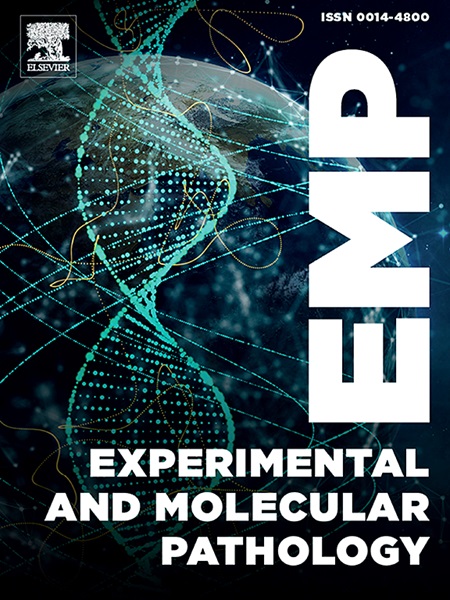大豆苷通过ERK和AKT信号通路介导MITF蛋白酶体降解抑制黑素形成
IF 3.7
4区 医学
Q2 PATHOLOGY
引用次数: 0
摘要
大豆黄酮是一种在大豆、葛根和各种豆类中发现的重要异黄酮,因其多种药理活性而被广泛研究,包括抗癌、抗氧化、抗炎、抗癫痫和酒精解毒特性。已有研究表明,葛根二氯甲烷组分(DCM-PLS)具有显著的抗黑素活性,其中大豆苷元被鉴定为主要活性化合物。然而,大豆苷元在色素沉着中的确切作用仍不完全清楚。本研究旨在探讨大豆苷元对色素沉着的影响,并探讨其作用机制。研究结果表明,大豆苷元不仅能抑制基础黑色素的生成,还能降低α-MSH、ACTH和紫外线照射诱导的黑色素合成。大豆苷元的作用主要通过激活细胞外信号调节蛋白激酶(ERK)和蛋白激酶B (AKT)途径介导。激活后,这些通路促进了黑色素细胞诱导转录因子(melanocyte Inducing Transcription Factor, MITF)的泛素化和降解,导致酪氨酸酶、TRP-1和TRP-2的表达降低,最终抑制黑色素生成。重要的是,我们的研究进一步证明了大豆苷元减少斑马鱼和人类皮肤外植体的色素沉着,突出了其作为治疗皮肤色素沉着相关疾病的潜在应用。本文章由计算机程序翻译,如有差异,请以英文原文为准。

Daidzin suppresses melanogenesis through ERK and AKT signaling pathways mediated MITF proteasomal degradation
Daidzin, a prominent isoflavone found in soybeans, Pueraria lobata, and various legumes, has been extensively investigated for its diverse pharmacological activities, which include anticancer, antioxidant, anti-inflammatory, antiepileptic, and alcohol detoxification properties. Previous studies have shown that the dichloromethane fraction of Pueraria lobata stem (DCM-PLS) exhibits significant anti-melanogenic activity, with daidzin identified as the principal active compound. However, the precise role of daidzin in pigmentation remains incompletely understood. This study aimed to investigate the effects of daidzin on pigmentation and to elucidate the underlying mechanisms. Our findings revealed that daidzin not only inhibited basal melanin production but also reduced melanin synthesis induced by α-MSH, ACTH, and UV exposure. The effects of daidzin were primarily mediated through the activation of the extracellular signal-regulated protein kinase (ERK) and protein kinase B (AKT) pathways. Upon activation, these pathways facilitated the ubiquitination and degradation of Melanocytes Inducing Transcription Factor (MITF), resulting in decreased expression of tyrosinase, TRP-1, and TRP-2, ultimately inhibiting melanogenesis. Importantly, our research further demonstrated that daidzin reduced pigmentation in both zebrafish and human skin explants, highlighting its potential application as a therapeutic approach for disorders related to skin pigmentation.
求助全文
通过发布文献求助,成功后即可免费获取论文全文。
去求助
来源期刊
CiteScore
8.90
自引率
0.00%
发文量
78
审稿时长
11.5 weeks
期刊介绍:
Under new editorial leadership, Experimental and Molecular Pathology presents original articles on disease processes in relation to structural and biochemical alterations in mammalian tissues and fluids and on the application of newer techniques of molecular biology to problems of pathology in humans and other animals. The journal also publishes selected interpretive synthesis reviews by bench level investigators working at the "cutting edge" of contemporary research in pathology. In addition, special thematic issues present original research reports that unravel some of Nature''s most jealously guarded secrets on the pathologic basis of disease.
Research Areas include: Stem cells; Neoangiogenesis; Molecular diagnostics; Polymerase chain reaction; In situ hybridization; DNA sequencing; Cell receptors; Carcinogenesis; Pathobiology of neoplasia; Complex infectious diseases; Transplantation; Cytokines; Flow cytomeric analysis; Inflammation; Cellular injury; Immunology and hypersensitivity; Athersclerosis.

 求助内容:
求助内容: 应助结果提醒方式:
应助结果提醒方式:


